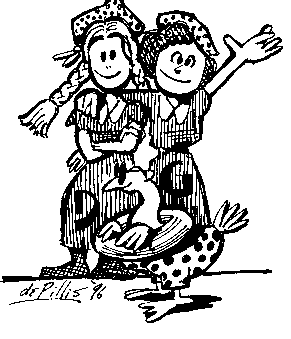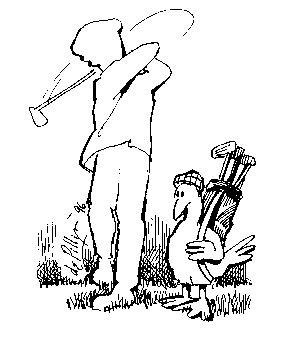
Dolcina and Guastella of Allora: A Fable for Our Time
by John de Pillis (Sunday, 27 October 1996, the Riverside Press Enterprise)
Once upon a time in the village of Allora, lived two sisters named Dolcina, who always told the truth, and Guastella who never told the truth.
One day, the sisters noticed their prize goose was missing. Guastella
ran straight away to the village square shouting, "A terrible thing
has happened! Our neighbor, Luigi, has stolen our prize goose!" When
the people asked if she was certain, Guastella said, "Yes, I saw him
take the goose last night." 
As the people started toward Luigi's house, Dolcina appeared, carrying the goose! "Oh, what good news," she said to one and all, "I found our goose! It had wandered off for a nice swim in the lake."
"Then it wasn't stolen?" asked the people. "Did not Luigi take your prize goose?"
"Oh, no," said Dolcina, "the gate was open and the goose simply walked out. Besides," Dolcina said with a laugh, "Luigi has been tending his sheep in the mountains for some days now."
The people realized that Guastella had not told them the truth and they asked her why she would accuse an innocent man.
"I did nothing wrong," Guastella replied. "Your question shows that you must be more aware that stealing is a very bad thing!"
Then, wagging her finger at the crowd, she said, sternly, "Surely, no one here feels kindly toward thieves!"
The crowd fell silent, feeling chastened by Guastella's righteous anger. With hardly a murmur, the people headed home. Some said that Guastella was very wise to be so cautious about stealing. One or two others noted that Dolcina had done a good thing by seeking the goose and telling the truth.
As the two sisters started home, Dolcina said, "What a fine day this turned out to be, Guastella. We have our goose --- which was not stolen at all --- and no one is angry at Luigi any more."
"What good is that?" snapped Guastella. "The next time a thief steals a goose, these stupid people will simply assume it just wandered away!"
A few days later, as Luigi was returning from the mountains, he gave a warm greeting to every one along the way. "How good it is," he thought, "to be in the village of Allora with so many fine neighbors and friends."
She is some piece of work, this Guastella of our fable! Thank goodness, no one today believes that lies are the same as truth. Or that the ends justify the means.
Or do they?
Let us repair to my garage and look through this pile of recyclable, yet recent newspapers. Hmm, here is an interesting front-page article in the Riverside Press Enterprise (30 September 1996) by David Zink. The headline reads, "Woods bias claim in ad unsupported."
The ad referred to in Zink's article, was paid for by Nike and appeared in the Wall Street Journal (29 August 1996). Nike quotes Tiger Woods as saying, "There are still courses in the United States that I am not allowed to play because of the color of my skin." Tiger Woods, as you probably know, is the famous 20- year old golf whiz who recently quit Stanford University in order to turn pro. Tiger's mother is Asian and his father is black.
James K. Glassman, a reporter for the Washington Post, read this ad and called Nike for names of these offending golf courses.
What, you may wonder, was Nike's reply to Glassman's request? 
In his Washington Post article (17 September 1996), entitled, "A Dishonest Ad Campaign:" Glassman reports the response of James Small, Nike's public relations director. Instead of supplying the names, Small admitted, "You're absolutely right. Tiger Woods can play on any golf course he wants." As if Nike's support of a misleading ad was a virtue of some kind, Small continued, "The goal of the ad was to raise awareness that golf is not an inclusive sport."
David Zink's Riverside Press article states more: Donna Gibbs, Nike's director of corporate communications, contradicted Small by claiming the ad was "factual" and, moreover, the United States Golf Association or the Professional Golf Association of America had a list of golf courses that unfairly discriminated.
But there is no such list. A fib was afoot. According to Zink's article, neither the USGA, the PGA, the National Golf Foundation, nor even the National Association for the Advancement of Colored People could supply such a list.
One way or the other, Nike was caught in a huge non-truth. But, in their words, they did it to "raise awareness" about racial bigotry. As Guastella of Allora would have it, we should ignore the lie and become more aware that bigotry is a bad thing!
If Nike gives us a Real-Life Guastella who doesn't tell the truth, then is there a Real-Life Dolcina who does? Let's go to this other pile of recyclable papers and ... What Ho! Look at this! It's a program from a University of Redlands conference (28 September 1996) with film director and writer, Freida Lee Mock, as the guest of honor. Yes, I remember now: There was a viewing and discussion of her 1994 Academy Award-winning documentary film, "Maya Lin: A Strong Clear Vision."
Freida Mock's film, produced with her husband Terry Sanders, tells a story of the young American, Maya Lin, who designed the Vietnam Veterans Memorial in Washington, D.C. We see that in 1979, a small group of Vietnam veterans, including Jan Scruggs, campaigned to establish some kind of memorial that would help to bring healing and closure to all who were still hurting from that conflict. These veterans decided that the final design would have to include the names of each of the 57,000 dead, and the structure would have to be wheel-chair accessible.
In a blind viewing (the identities of the contestants are unknown) the judges evaluated over 1,400 entries, some submitted by well-known professional architects. In the film, one participant describes how the judges stopped in their tracks when they came across Maya Lin's surprisingly simple pastel sketch. There were no statues, horses, or obelisks. There was just a plain triangular shape embedded in the lawn.
When the address of the winner was finally revealed, one of the judges remarked, "Say, isn't that the location of student housing at Yale?" Indeed, it was. The winner, Maya Lin, was a 20-year old architecture student at Yale University. This was affirmative action at its best!
Did success and applause follow Maya Lin because of her achievement? Not right away, as the film clearly reveals.
There was outrage borne of ignorance and hate: Some objected to the fact that Maya Lin was the daughter of Asian parents (they are academics at Ohio University in Athens, Ohio). Some said that a female had no business telling men how to grieve or how to honor other men --- although the Memorial carries the names of women, as well. Others were suspicious of a Communist plot.
There was outrage borne of mis-interpretation: Vietnam veteran Tom Carhart, who was spat upon when he came home, protested angrily because, as he said, the black granite gave the subtle message that the whole Vietnam episode was dark --- and ignoble.
There was outrage borne of political expediency: James Watts, Secretary of the Interior wanted to scuttle the Memorial unless some statues or more conventional symbols were used (He failed). Ronald Reagan did not attend the Vietnam Veteran Memorial dedication ceremony in November of 1982.
Maya Lin had to personally defend herself through these and many other
acrimonious battles. 
Viewing the film, you sense the power of Maya Lin's understated design. Almost by definition, memorials are imposing and bold -- - the viewer is supposed to be humbled by grandeur. But with this Vietnam Veterans Memorial, the heart of the design is the plain granite, eye-level wall of names. Each name is reachable and, more importantly, each name is meant to be touched.
There is awe when one experiences this memorial. But it is not an awe that sucks your breath away like a cold blast of a winter's wind. With this work of art, you feel a sublime, private revery --- a warm rapport with each name you touch and see. There is an undeniable, personal dimension to this public memorial.
After the film, there was a discussion between the audience and a panel which included a Vietnam veteran, a Vietnamese student, and Freida Mock.
The Vietnam veteran on the panel, a black man, told of his surprise and hurt when he returned to a hostile homecoming. To this veteran, the Memorial symbolized a long-awaited public acknowledgment. Now, he said, his healing could begin.
The Vietnamese student on the panel, a woman in her twenties, explained that she learned to deeply hate Americans because of the war. (Her father still hates Americans.) This film --- this very film --- showing scenes of the Memorial being visited by veterans, friends, and grieving families, reached so deep down, that her heart was compelled to forgive. "I see from the film," she said in an emotional closing, "we were all victims." Now, she was able to heal.
A woman in the audience stood up and announced that she was one of the hippies who spat on the boys coming home from Vietnam. "Now, I understand what others feel," she said. "My heart is not hard any more." She, too, is healing.
What does all this mean? Maybe it proves that a good fable has to be a template of reality.
We recounted the fable of Guastella of Allora, who didn't tell the truth, and her sister, Dolcina, who did tell the truth.
In the stacks of recyclable newspapers, there is the real story of individuals in Nike who didn't tell the truth about the struggle of the talented 20-year old Tiger Woods. Nike's distortions made people disgusted and angry.
These stacks also contain the real story of Freida Lee Mock who did tell the truth about the struggle of talented 20-year old Maya Lin. Her truth made people proud and soothed their hurting souls.
It's time to leave and close the garage door now. I suspect the stories about the person who doesn't tell the truth, and the person who does tell the truth, will probably recycle forever.
